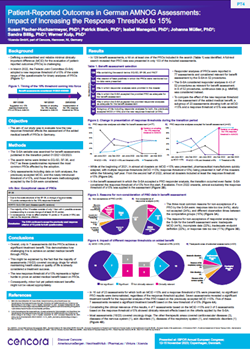Enhancing Patient-Reported Outcomes (PROs) in German AMNOG Assessments: Insights from the ISPOR Europe 2023 Conference
By AmerisourceBergen

Examining the Impact of Increasing the Response Threshold to 15% on PRO Analysis

At the ISPOR Europe 2023 conference, authors presented a poster examining the impact of increasing the response threshold to 15% on patient-reported outcomes (PROs) in German AMNOG (Arzneimittelmarktneuordnungsgesetz, English translation: "Pharmaceutical Market Reorganisation Act") assessments. This research was inspired by concerns raised by pharmaceutical companies regarding the difficulty of demonstrating added medical benefit under the new standardized threshold. By investigating the actual impact and challenges posed by this higher threshold, the study aimed to shed light on the implications for showcasing improved patient outcomes within German benefit assessments.

Key Takeaways
The research yielded two noteworthy key takeaways. Firstly, pharmaceutical companies' concerns about the increased response threshold were justified. The study confirmed that meeting this higher threshold indeed posed a greater hurdle for demonstrating added medical benefit based on PROs.
Additionally, it was found that only in about half of the analyzed assessments PRO data presented by the pharmaceutical company for evaluating the benefit of the drug were considered. Even though the analyzed instruments are very well established and validated. Furthermore, of the PRO data that the G-BA (Gemeinsamer Bundesausschuss, English translation: Joint Federal Committee) considered suitable for the benefit assessment, only 30% showed a statistically significant treatment benefit of the assessed drugs. This might be explained by the fact that the majority of the accepted PRO data originated from assessments of oncology drugs. With oncology drugs in particular, maintaining the patient’s health status or quality of life is considered a treatment success and statistically significant treatment benefits are mostly not expected.
Additionally, it was found that only in about half of the analyzed assessments PRO data presented by the pharmaceutical company for evaluating the benefit of the drug were considered. Even though the analyzed instruments are very well established and validated. Furthermore, of the PRO data that the G-BA (Gemeinsamer Bundesausschuss, English translation: Joint Federal Committee) considered suitable for the benefit assessment, only 30% showed a statistically significant treatment benefit of the assessed drugs. This might be explained by the fact that the majority of the accepted PRO data originated from assessments of oncology drugs. With oncology drugs in particular, maintaining the patient’s health status or quality of life is considered a treatment success and statistically significant treatment benefits are mostly not expected.
Hypothesis and surprising findings
The researchers' hypothesis regarding an increased difficulty in demonstrating added medical benefit was partially confirmed. While the number of assessments demonstrating a clinically significant treatment benefit were indeed lower with the new 15% response threshold, it was not significantly more challenging. This might be explained by the fact that PRO’s acceptance rate has already been low prior to the implementation of the 15% response threshold.
However, a surprising finding emerged regarding well-established instruments used for PRO assessment. Despite their validation and approval in the past, a considerable number of these instruments were declined during benefit assessments due to failure in study design or failure to match appropriate comparators or achieve sufficient response rates. This highlights the importance of careful consideration when selecting assessment instruments even within established ones.
The authors' research unveiled important insights into how increasing the response threshold impacts PRO analysis within German AMNOG assessments. Pharmaceutical companies face greater challenges in demonstrating added medical benefits under this higher threshold; however, this hurdle is not insurmountable.
Moving forward, stakeholders involved in AMNOG assessments should consider refining study designs and addressing limitations associated with instrument selection and data collection methods. By continuously improving these processes while balancing rigorous evaluation standards with practical considerations, Germany can enhance its ability to assess patient-reported outcomes effectively and facilitate evidence-based decision-making within healthcare systems.
The recognition received as a Top 5% Finalist at ISPOR Europe 2023 underscores the scientific merit and significance of this research presentation's findings within its field.
However, a surprising finding emerged regarding well-established instruments used for PRO assessment. Despite their validation and approval in the past, a considerable number of these instruments were declined during benefit assessments due to failure in study design or failure to match appropriate comparators or achieve sufficient response rates. This highlights the importance of careful consideration when selecting assessment instruments even within established ones.
The authors' research unveiled important insights into how increasing the response threshold impacts PRO analysis within German AMNOG assessments. Pharmaceutical companies face greater challenges in demonstrating added medical benefits under this higher threshold; however, this hurdle is not insurmountable.
Moving forward, stakeholders involved in AMNOG assessments should consider refining study designs and addressing limitations associated with instrument selection and data collection methods. By continuously improving these processes while balancing rigorous evaluation standards with practical considerations, Germany can enhance its ability to assess patient-reported outcomes effectively and facilitate evidence-based decision-making within healthcare systems.
The recognition received as a Top 5% Finalist at ISPOR Europe 2023 underscores the scientific merit and significance of this research presentation's findings within its field.
Fill out the form to download the poster and learn more

Download the poster
Pardot Form
Authors: Susan Fischer-Huchzermeyer, PhD; Patrick Blank, PhD; Isabel Manegold, PhD; Johanna Müller, PhD; Sandra Billig, PhD; Werner Kulp, PhD
References
BMG (Bundesministerium für Gesundheit). Bekanntmachung eines Beschlusses des Gemeinsamen Bundesausschusses über eine Änderung der Verfahrensordnung: Änderung der Modulvorlage in der Anlage II zum 5. Kapitel. December 16, 2021. Accessed September 22, 2023. https://www.bundesanzeiger.de/pub/publication/8JgVtHxgy0ED31usNCE/content/8JgVtHxgy0ED31usNCE/BAnz%20AT%2022.03.2022%20B2.pdf?inline.
G-BA (Gemeinsamer Bundesausschuss). Zusammenfassende Dokumentation zum Beschluss des Gemeinsamen Bundesausschusses über eine Änderung der Verfahrensordnung: Änderung der Modul-vorlage in der Anlage II zum 5. Kapitel. December 16, 2021. Accessed September 22, 2023. https://www.g-ba.de/downloads/40-268-8140/2021-12-16_VerfO_Aenderung-Modulvorlage-Anlage-II-Kap-5_ZD.pdf





